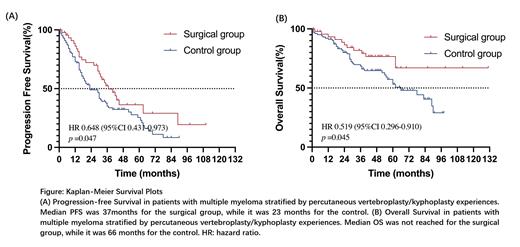Objective To evaluate the efficacy and prognosis of percutaneous vertebroplasty/ kyphoplasty (PVP/PKP) in patients with newly diagnosed multiple myeloma (NDMM).
Methods Clinical data of NDMM patients who underwent PVP/PKP during front-line regimen at Peking Union Medical College Hospital from January 1 2003 to June 30, 2023, were retrospectively analyzed. Patients with comparable severity of bone disease and no orthopedic surgery were selected as controls. Visual analogue scale (VAS) score, progression-free survival (PFS), and overall survival (OS) were compared. Statistical methods mainly adopt χ 2-test, t-test, Kaplan Meier, and COX regression analysis.
Results Baseline characteristics were matched between the surgical group (n=51 with 56 surgeries) and non-surgical group(n=102), including gender, age, paraprotein type, serum M protein level, International Staging System(ISS), numbers of lytic lesions, cytogenetic abnormalities, first-line treatment, and autologous stem-cell transplantation (ASCT)( P>0.05). Bone lesions for PVP/PKP were located at thoracic vertebrae (53.6%, 30/56) or lumbosacral vertebrae (46.4%, 26/56). The postoperative VAS score was significantly improved (2.25±0.81 vs 5.92±1.05 , P<0.001). The median follow-up time was 51[38,70] months. Kaplan-Meier survival analysis suggested that PFS (37[17,89] vs 23[12.61] months, HR 0.648, 95%CI 0.431-0.973, P=0.047) and OS (not reached vs 66[28, NR] months, HR 0.519, 95%CI 0.296-0.910, P=0.045) in the surgical group were significantly improved. COX multivariate analysis suggested that PVP/PKP was an independent prognostic factor for PFS ( P=0.021, HR 0.589,95%CI 0.376-0.922)and OS( P=0.038, HR 0.496,95%CI 0.255-0.963), while not receiving ASCT or ISS stage II/III were independent risk factors. Subgroup analysis confirmed that patients with ISS II/III or non-ASCT achieved better PFS and OS in the surgical group(PFS: P=0.033, P=0.040; OS: P=0.024, P=0.018), while patients with ISS I or receiving ASCT had similar survival outcome(PFS P>0.05; OS P>0.05) between two groups.
Conclusion For NDMM patients, PVP/PKP is associated better quality of life due to alleviating bone pain. Meanwhile, it improves the PFS and OS of patients with ISS stage II/III or non-transplant eligible, which suggests that shortening the gap from symptom onset to diagnosis by surgical pathology will improve response in MM.
Disclosures
No relevant conflicts of interest to declare.


This feature is available to Subscribers Only
Sign In or Create an Account Close Modal